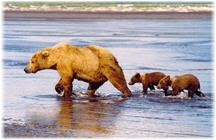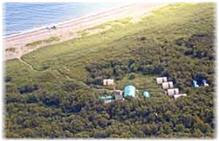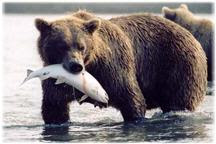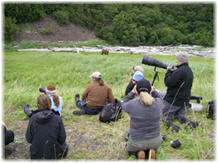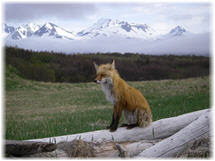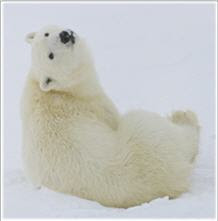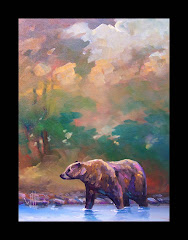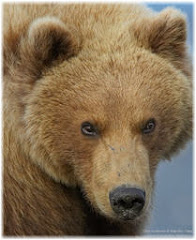As with brown bears, black bears spend the winter months
in a state of hibernation. Their body temperatures drop,
their metabolic rate is reduced, and they sleep for long
periods. Bears enter this dormancy period in the fall,
after most food items become hard to find. They emerge in
the spring when food is again available.
Occasionally, in
the more southern ranges, bears will emerge from their
dens during winter. In the northern part of their range,
bears may be dormant for as long as seven to eight months.
Females with cubs usually emerge later than lone bears.
Dens may be found from sea level to alpine areas. They may
be located in rock cavities, hollow trees, self-made
excavations, even on the ground.
Friday, May 30, 2014
Thursday, May 29, 2014
Wolves
Wolves run on their toes, which helps them to stop and turn
quickly and to prevent their paw pads from wearing down.
Under certain conditions, wolves can hear as far as six miles away in the forest and ten miles on the open tundra.
A wolf pup’s eyes are blue at birth. Their eyes turn yellow by the time they are eight months old.
Wolves have about 200 million scent cells. Humans have only about 5 million. Wolves can smell other animals more than one mile (1.6 kilometers) away.
Under certain conditions, wolves can hear as far as six miles away in the forest and ten miles on the open tundra.
A wolf pup’s eyes are blue at birth. Their eyes turn yellow by the time they are eight months old.
Wolves have about 200 million scent cells. Humans have only about 5 million. Wolves can smell other animals more than one mile (1.6 kilometers) away.
Tuesday, May 27, 2014
Sandhill Cranes
Omnivorous ground feeders, cranes eat frogs, rodents,
insects, bulbs, seeds, and berries as well as occasional
seashore delicacies. They have adapted well to agriculture
and during the winter and on migration, feed largely on
waste grain and small animals associated with farm fields.
The dance of the sandhills may be one of the strangest breeding displays on the tundra. Often called a mating dance, display activity reaches a peak in late winter and early spring, but it has also been seen at other times of the year when two cranes meet. The ritual starts with a deep bow followed by great leaps, hops, skips, turns, and more bows. This dance can go on for many minutes.
The dance of the sandhills may be one of the strangest breeding displays on the tundra. Often called a mating dance, display activity reaches a peak in late winter and early spring, but it has also been seen at other times of the year when two cranes meet. The ritual starts with a deep bow followed by great leaps, hops, skips, turns, and more bows. This dance can go on for many minutes.
Monday, May 26, 2014
Sunday, May 25, 2014
Bear Facts
- Because a giant panda’s eye is a vertical slit, like many nocturnal animals it can see by day and by night.
- Once bears breed, they go their separate ways. Male bears do not help the mother bear raise the cubs.
- When U.S. President Theodore (Teddy) Roosevelt refused to shoot a black bear cub on a hunting trip, a cartoon featured the event, and soon stuffed toy manufacturers popularized “Teddy’s bear.”
- Only about 1,000 giant pandas live in the wild today.
- The lips of bears are not attached to their gums, which make their lips look rubbery.
Saturday, May 24, 2014
Friday, May 23, 2014
Black-capped chickadee
The black-capped chickadee is found in deciduous and
mixed forests, open woods, willow thickets, cottonwood
groves, parks and disturbed areas.
The chickadee generally remains within its breeding range throughout the year but periodically disperses during fall and winter. Flocks of six to 12 chickadees roam over winter feeding ranges of about 40 acres, regularly visiting known food sites. They normally return each evening to roost among a particular patch of trees though some find shelter in cavities, under the eaves of houses or other protected sites. The birds may migrate short distances.
The chickadee generally remains within its breeding range throughout the year but periodically disperses during fall and winter. Flocks of six to 12 chickadees roam over winter feeding ranges of about 40 acres, regularly visiting known food sites. They normally return each evening to roost among a particular patch of trees though some find shelter in cavities, under the eaves of houses or other protected sites. The birds may migrate short distances.
Thursday, May 22, 2014
Wolves
- Britain’s King Edgar imposed an annual tax of 300 wolf skins on Wales. The Welsh wolf population was quickly exterminated.
- In 1500, the last wolf was killed in England. In 1770, Ireland’s last wolf was killed. In 1772, Denmark’s last wolf was killed.
- After hearing of “frightening spirits” in the woods with human features that walked on four legs, Reverend Singh in 1920 discovered a den with two cubs and two human girls, one around age 7 or 8, the other around 2. After being brought back to “civilization,” the younger one died within a year. Recently, authors have questioned the validity of this story as modern knowledge has revealed that wolf-like behavior is often seen in autistic or abused children.
- Sextus Placitus, in his fifth-century B.C. Medicina de quadrupedibus (Medicinals from Animals), claims that sleeping with a wolf’s head under one’s pillow would cure insomnia.
- In 1934, Germany became the first nation in modern times to place the wolf under protection. Influenced by Friedrich Nietzsche’s (1844-1900) and Oswald Spengler’s (1880-1936) belief that natural predators possessed more vigor and virility than their prey, the protection was probably more for an “iconic” wolf than the actual wolf, particularly since the last wolves in Germany were killed in the middle of the nineteenth century.
- Unlike other animals, wolves have a variety of distinctive facial expressions they use to communicate and maintain pack unity.
- The Japanese word for wolf means “great god.”
Wednesday, May 21, 2014
Beaver
After mating (which takes place in January or February),
the female prepares for a new litter. Two to four kits on
average are born anytime from late April to June. Their
eyes are open at birth and the kits are covered with soft
fur. They can swim at 4 days and dive at 2 months of age.
The young beavers live with their parents until they are 2
years old. Then they leave to find their own homes.
To survive, beavers must be assured of 2 or 3 feet (0.6–0.9 m) of water year-round. Water provides a refuge from enemies and a way to float and transport heavy objects such as branches and logs for food and construction. Food for winter use must be stored in underwater food caches during autumn.
To survive, beavers must be assured of 2 or 3 feet (0.6–0.9 m) of water year-round. Water provides a refuge from enemies and a way to float and transport heavy objects such as branches and logs for food and construction. Food for winter use must be stored in underwater food caches during autumn.
Tuesday, May 20, 2014
Alaska Vole
Northern red-backed voles can breed up to four times per
year. Young are born May-September and probably average
two litters per year. Litter sizes are between four to
nine, and average about six. About 20 percent of females
from the first litter breed during the summer of their
birth; the remaining 80 percent and later litters breed
the following May.
Gestation is 17–19 days. Young are weaned in 12–17 days and are mature in two to four months. Little is known about their reproduction strategy in the wild, but voles have displayed a polygynous mating system in captivity.
Gestation is 17–19 days. Young are weaned in 12–17 days and are mature in two to four months. Little is known about their reproduction strategy in the wild, but voles have displayed a polygynous mating system in captivity.
Monday, May 19, 2014
Sunday, May 18, 2014
Friday, May 16, 2014
Eagles
Juvenile bald eagles are often confused with golden eagles (Aquila
chrysaetos). Where the two species coexist, the bald
eagle is distinguished by a lack of feathers on its lower legs
and a whitish lining on the forward part of its wings.
Bald eagles often use and rebuild the same nest each year. Nest trees are usually close to the water, allow for a clear view of the surrounding area, and often provide sparse cover above the nest. Nest building begins in April and both the male and female gather nest material, In late April, two (sometimes three) dull white or creamy yellow eggs are laid several days apart. Incubation lasts about 35 days. When the young hatch, sibling rivalry is common and the weaker, usually younger, chick is killed or starved. The surviving young leave the nest after about 75 days and do not attain adult plumage and breed for about 4 or 5 years. After the breeding season, bald eagles congregate where food is plentiful and they may continue to roost near the nest tree.
Bald eagles often use and rebuild the same nest each year. Nest trees are usually close to the water, allow for a clear view of the surrounding area, and often provide sparse cover above the nest. Nest building begins in April and both the male and female gather nest material, In late April, two (sometimes three) dull white or creamy yellow eggs are laid several days apart. Incubation lasts about 35 days. When the young hatch, sibling rivalry is common and the weaker, usually younger, chick is killed or starved. The surviving young leave the nest after about 75 days and do not attain adult plumage and breed for about 4 or 5 years. After the breeding season, bald eagles congregate where food is plentiful and they may continue to roost near the nest tree.
Thursday, May 15, 2014
Black Bears
For most of the year, black bears are solitary creatures,
except from June through July when mating takes place. The
cubs are born in their dens following a gestation period
of about seven months. The cubs are born blind and nearly
hairless, weighing in under a pound. One to four cubs may
be born, but two is most common. Cubs remain with their
mothers through the first winter following birth.
Black bears mature sexually at 3 to 6 years of age, depending upon their environment. In the more southern parts of their range, bears will breed every other year; however, if a litter is lost early during the first summer, the sow will breed again that year. In more marginal environments such as northern Alaska, black bears keep their cubs with them an extra year and will breed every third year.
Black bears mature sexually at 3 to 6 years of age, depending upon their environment. In the more southern parts of their range, bears will breed every other year; however, if a litter is lost early during the first summer, the sow will breed again that year. In more marginal environments such as northern Alaska, black bears keep their cubs with them an extra year and will breed every third year.
Wednesday, May 14, 2014
The Lore of Ravens
Ravens are omnivorous, consuming a wide variety of both
plant and animal matter. They are notorious scavengers and
are common visitors to garbage dumps, although at times
they are also predatory on small animals. Ravens will hide
or cache food supplies, and will raid other ravens’
caches, creating social dynamics involving disguising
caches and creating fake caches.
They also have the habit, like most hawks and owls, of regurgitating undigestible food in the form of a pellet. An analysis of hundreds of raven pellets from Umiat, Alaska, indicated that 50 percent of the raven's winter diet consisted of live prey (mostly small mammals) captured by ravens. Diets consist of grains, berries, fruit, small invertebrates, amphibians, reptiles, small mammals and birds.
They also have the habit, like most hawks and owls, of regurgitating undigestible food in the form of a pellet. An analysis of hundreds of raven pellets from Umiat, Alaska, indicated that 50 percent of the raven's winter diet consisted of live prey (mostly small mammals) captured by ravens. Diets consist of grains, berries, fruit, small invertebrates, amphibians, reptiles, small mammals and birds.
Tuesday, May 13, 2014
Harbor Seals
In Alaska, single pups are born between May and
mid-July. Young pups are able to swim almost immediately
after birth. They normally remain with their mothers about
one month, after which they are weaned and separate from
their mother. At that time over half their body weight may
consist of fat, providing them a head start on
self-sufficiency. Sexual maturity occurs at between 3 and
7 years. Mature females mate shortly after weaning their
pups. Development of the embryo is suspended for about 11
weeks; a trait called embryonic diapause (i.e., delayed
implantation). Active fetal development is about 8½
months.
Births of harbor seal pups are not restricted to a few major rookeries (as is the case for many species of pinnipeds) but occur at many haul-out sites. The sex ratio of harbor seals at birth is approximately equal and remains so until about 5 years of age. Thereafter mortality rates for males are higher, and females become relatively more abundant. Maximum ages estimated from annual rings in their teeth are 26 years for a male and 35 years for a female.
Births of harbor seal pups are not restricted to a few major rookeries (as is the case for many species of pinnipeds) but occur at many haul-out sites. The sex ratio of harbor seals at birth is approximately equal and remains so until about 5 years of age. Thereafter mortality rates for males are higher, and females become relatively more abundant. Maximum ages estimated from annual rings in their teeth are 26 years for a male and 35 years for a female.
Monday, May 12, 2014
Facts about Wolves
- According to Pliny the Elder, a first-century Greek scholar, wolf teeth could be rubbed on the gums of infants to ease the pain of teething. He also reported that wolf dung could be used to treat both colic and cataracts.
- The Aztecs used wolf liver as an ingredient for treating melancholy. They also pricked a patient’s breast with a sharpened wolf bone in an attempt to delay death.
- During the Middle Ages, Europeans used powdered wolf liver to ease the pain of childbirth and would tie a wolf’s right front paw around a sore throat to reduce the swelling. Dried wolf meat was also eaten as a remedy for sore shins.
- The Greeks believed that if someone ate meat from a wolf-killed lamb, he or she ran a high risk of becoming a vampire.
- During the reign of Edward the Confessor, which began in 1042, a condemned criminal was forced to wear a wolf-head mask and could be executed on a “wolf’s head tree” or the gallows where a wolf might be hanged next to him.
- Werewolf (wer “man” + wulf “wolf”) trials (which can be distinguished from witchcraft trials) led to hundreds of executions during the 1600s. Men, women, and children—many of whom were physically and mentally handicapped—were put to death.
- The Cherokee Indians did not hunt wolves because they believed a slain wolves’ brothers would exact revenge. Furthermore, if a weapon were used to kill a wolf, the weapon would not work correctly again.
- In approximately the year 800, Charlemagne founded a special wolf-hunting force, the Louveterie, which remained active until 1789. It was reactivated in 1814, and the last French wolf was killed in 1927.
Sunday, May 11, 2014
Saturday, May 10, 2014
Ermine
Ermine mate in late spring to early summer. Implantation
of fertilized ova is delayed until early in the following
spring, and once this happens there is a gestation period
of about four weeks. One litter of four to 13 (average of
six) young is born usually in April or May in North
America. Females care for young alone. Lactation may
continue until seven to 12 weeks, although young begin to
venture from the nest at six to eight weeks. The nest is
typically lined with rodent hair and is often a former
burrow of a rodent, or may be in a rock pile, hollow log
or crevice. Females are sexually mature at three to four
months, while males likely reach sexual maturity at 12
months. Females may survive for at least two breeding
seasons but males generally do not survive this long.
Their reproductive success is highly dependent on food
availability.
Friday, May 9, 2014
Sea Urchin
Their range occurs from Northern Japan and Alaska to
Baja California. In Southeast Alaska, the red sea urchin
occurs primarily on rocky shorelines of the outside coast
with largest concentrations in southern southeast. They
can inhabit intertidal depth to up to 90 m.
Fast Facts
- Size
0 – 18 cm in diameter - Range/Distribution
From Northern Japan and Alaska to Baja California, intertidal to 90 m depth - Diet
Seaweed, invertebrates - Predators
Sea otters and star fish - Reproduction
Males and females, broadcast spawners, external fertilization
Thursday, May 8, 2014
Wednesday, May 7, 2014
Tuesday, May 6, 2014
Bird Facts
- Birds are warm blooded.
-
There are around 10000 different species of birds
worldwide.
-
The Ostrich is the largest bird in the world. It also lays
the largest eggs and has the fastest maximum running speed
(97 kph).
-
Scientists believe that birds evolved from theropod
dinosaurs.
-
Birds have hollow bones which help them fly.
-
Some bird species are intelligent enough to create and use
tools.
-
The chicken is the most common species of bird found in the
world.
-
Kiwis are endangered, flightless birds that live in New
Zealand. They lay the largest eggs relative to their body
size of any bird in the world.
-
Hummingbirds can fly backwards.
-
The Bee Hummingbird is the smallest living bird in the
world, with a length of just 5 cm (2 in).
-
Around 20% of bird species migrate long distances every
year.
- Homing pigeons are bred to find their way home from long distances away and have been used for thousands of years to carry messages.
Monday, May 5, 2014
Sunday, May 4, 2014
Saturday, May 3, 2014
Thursday, May 1, 2014
Moose Facts
- Size
Up to 1,600 pounds. - Distribution
Generally associated with northern forests; found in Alaska from the Unuk River in Southeast to the Colville River on the Arctic Slope. - Diet
Herbivorous, eating willow, birch, and aspen leaves and twigs, along with sedges, Equisetum, pond weeds, and grasses. - Predators
Wolves, black bears, and brown bears. - Reproduction
Usually one calf is born, but twins can occur if food has been plentifull.
Subscribe to:
Comments (Atom)


.jpg)
.jpg)

.jpg)
.jpg)
.jpg)
.jpg)
.jpg)
.jpg)

.jpg)

.jpg)
.jpg)
.jpg)
.jpg)
.jpg)

+(Small).jpg)
.jpg)

.jpg)

.jpg)
.jpg)
.jpg)


.JPG)
.JPG)
.JPG)
.jpg)
.jpg)
.jpg)
.jpg)
.JPG)
.JPG)
.JPG)
.JPG)
.JPG)
.JPG)
.JPG)
.JPG)
.JPG)
.JPG)
.jpg)




 Alaska Time
Alaska Time